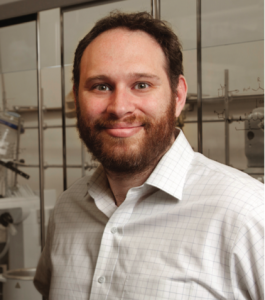Bacteria are double-edged swords. Some microbes are necessary for healthy biological functioning. Others, such as Staphylococcus aureus, can evade the body’s immune response, grow out of control, and cause serious disease. A new discovery from the Spiegel Laboratory in the Yale Chemistry Department elucidates the potential mechanism by which S. aureus hides from the body’s defenses.
Multi-drug resistant bacteria pose a serious public health threat because they are not easily killed by common antibiotics. Notably, certain strains of antibiotic resistant S. aureus have been responsible for the MRSA outbreaks that have plagued public health authorities. Yale physician-scientist Samir Gautam was one of many who wondered why conventional antibodies are ineffective at killing S. aureus. He was working as a postdoctoral research in organic chemistry, and he wanted to develop a vaccine against S. aureus. Then, he came across some electron micrographs of S. aureus published in the 1980s. “When we saw the scanning electron micrographs of the staphylococcal cell envelope covered with the hair-like wall teichoic acids, it struck us that these may be the reason,” Gautam said.
Wall teichoic acids are long chains of sugar molecules that are covalently bound to the peptidoglycan cell wall of Gram-positive bacteria like S. aureus. Peptidoglycans, mesh-like structures composed of sugars and peptides, provide shape to bacteria. In S. aureus wall teichoic acids are known to contribute to infection and shield the bacteria from environmental threats. Based on this shielding function, scientists hypothesized that the wall teichoic acids could act as an immunological cloak, preventing conventional antibodies from recognizing and attacking the bacteria. Because the peptidoglycan cell wall is common to many species of bacteria, such antibodies could provide broad protection against S. aureus and other bacteria.
Since commercially available antibodies for the bacterial cell wall are not specific enough to only target peptidoglycan, the lab decided to fix a chemical antigen in the cell wall. This would allow antibodies designed to recognize these chemical tags to bind with great affinity. To accomplish their goal, the researchers took advantage of a particular enzyme involving cell wall synthesis, successfully labeling the cell wall without disturbing its assembly or adversely affecting its integrity. The scientists then assessed the recruitment of a highly specific antibody to this foreign epitope, and they found that they were indeed able to engineer the specificity they needed using the chemical tags.
Gautam applied this technique to the question of how and why S. aureus is able to survive attack by antibodies. The study found that antibody binding to the cell wall was blocked in the presence of teichoic acids but successful when the bacteria was stripped of this protective coating. These findings indicated to Gautam that teichoic acids play an important role in shielding the bacteria from the immune system.
“The study exemplifies the power of adopting a cross-disciplinary approach to basic biology research,” Gautam said. Techniques in chemistry and synthetic biology were critical to the team’s work, and the combination of multiple armories from across different fields promises to bolster the search for solutions to some of the most pressing scientific problems.

“This work offers new insights into the function of wall teichoic acids and the mechanisms this important human pathogen uses to evade the human immune system,” Gautam said. The findings provide a promising starting point for the development of better drugs and vaccines against antibiotic resistant bacteria.
